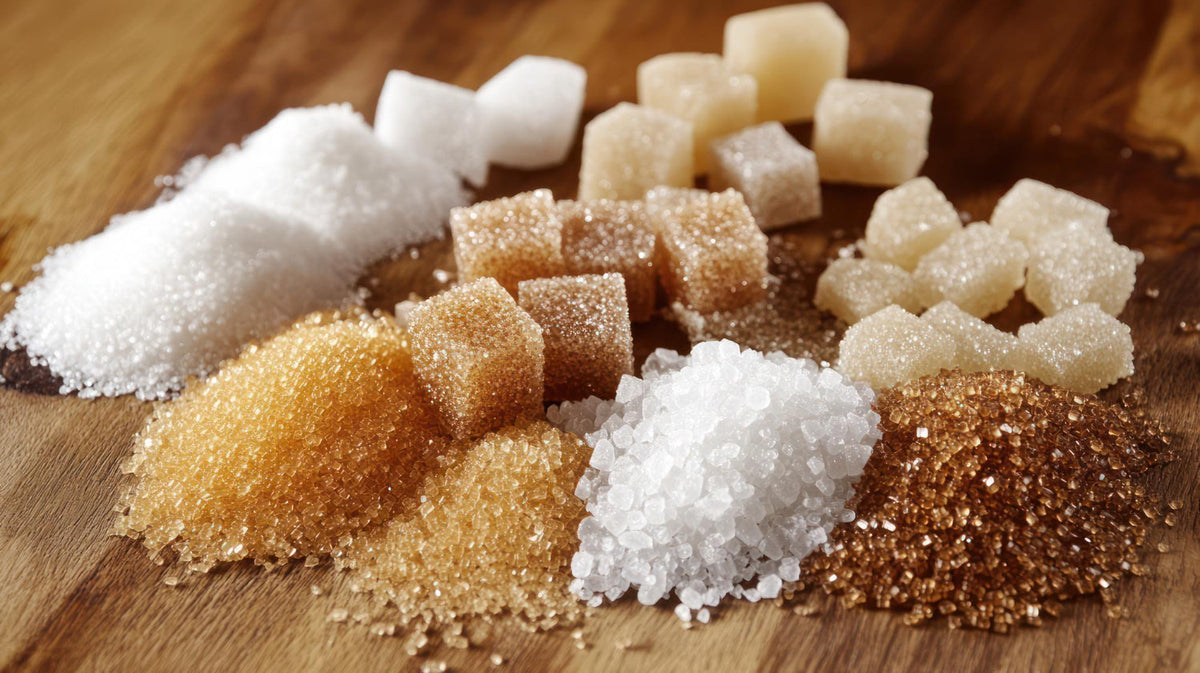Is Sugar Really a Toxin? What the Science Says About Metabolic Stress and Sweet Alternatives

It isn’t the molecule that’s poisonous—it’s the chronic overload. In excess, sugar shifts from quick fuel to a driver of metabolic stress.
Skim-first guide: look for Quick Answer notes, the comparison table, and the 14–30 Day Sugar Reset plan below.
“Is sugar a toxin?” is a powerful question because it compresses a complex metabolic story into a single, provocative label. Toxicology, however, is about dose and context. Glucose is a native fuel; your brain and muscles rely on it every day. Problems emerge when ultra-processed patterns deliver large, frequent sugar hits that outpace the body’s ability to buffer swings in blood glucose and fructose. The result isn’t instant poisoning, but metabolic stress: repeated insulin spikes, advanced glycation end-products (AGEs) that damage proteins and vessel walls, hepatic fat accumulation from excess fructose, and mitochondrial oxidative stress that can leave you flat by mid-afternoon. Over months and years, this pattern raises risk for insulin resistance and cardiometabolic disease.
That’s why the “toxin” framing misleads. A spoon of sugar in tea won’t wreck a metabolically healthy person; yet a steady drip of sugary drinks, confections, and refined snacks can crowd out fibre, protein, and micronutrients, blunting satiety and nudging weight upward. The practical goal isn’t purity culture; it’s restoring metabolic flexibility—the body’s ability to switch between fuels smoothly, keeping glucose in a stable, healthy range. For most Australians, that looks like: fewer liquid sugars; meals anchored by protein, healthy fats, and plants; regular movement; and smarter ways to satisfy a sweet tooth. Some natural sweeteners have a lower glycaemic impact than table sugar; raw honey can fit sparingly for flavour; and targeted nutrients such as magnesium, chromium, and CoQ10 support energy pathways while you recalibrate habits. This guide takes a clinical, Australia-first lens to explain mechanisms, compare common sweeteners, and offer pragmatic swaps that support long-term health—without the scare language.
Sugar & Metabolic Stress
Quick reference Glucose spikes → AGEs/oxidative stress → liver fat. Counter with fibre, protein, movement, sleep, and lower-GI sweeteners.
Sugar itself isn’t inherently toxic; it’s the overload that causes trouble. When the body receives more glucose and fructose than it can efficiently use or store, the surplus begins to stress key metabolic systems. Each spike in blood sugar triggers insulin release to shuttle glucose into cells. Frequent, high-volume spikes can desensitise those cells, a phenomenon called insulin resistance. Over time, the pancreas compensates by producing even more insulin, setting the stage for metabolic syndrome.
Fructose adds its own layer of stress. It’s processed primarily by the liver, where excess intake can promote fat accumulation and increase triglycerides. This contributes to non-alcoholic fatty liver changes—a slow, silent process that amplifies inflammation. Meanwhile, sugar reacts with proteins to form advanced glycation end-products (AGEs), compounds that stiffen blood vessels and impair tissue repair. The combined effect is like metabolic noise: disrupted energy flow, sluggish mitochondria, and persistent low-grade inflammation.
The paradox is that glucose is still essential for energy, especially for the brain and muscles. The problem arises from frequency and quantity, not existence. When sugary drinks, sweets, and refined carbohydrates dominate meals, the body loses its flexibility to switch between glucose and fat as fuel. Restoring that flexibility is the goal—spacing meals, reducing added sugars, and favouring nutrient-dense whole foods recalibrate metabolism naturally. Balanced sugar use means turning a daily flood into an occasional tide, allowing your body’s energy systems to function as designed.
Sugar: Fuel or “Toxin”? Quick Answers to Common Questions
Quick Answer Is sugar a toxin?
No. Sugar is a physiological fuel. In chronic excess, it functions like a metabolic stressor (insulin spikes, AGEs, liver fat).
Quick Answer Do humans really need sugar?
We need glucose for cells, which can come from carbohydrates or be made from protein. Added sugars are not required for health.
Quick Answer What organ is sugar worst for?
Liver (fructose → fat accumulation), pancreas (insulin demand), and blood vessels (glycation). It’s the pattern that harms.
Quick Answer 7 vs 30 days without added sugar
7 days: taste resets, cravings drop. 30 days: steadier energy, lower variability in glucose; many prefer less-sweet foods.
Myth check: There’s no instant “flush.” Hydration, balanced meals, fibre, movement, and sleep do the real work over days to weeks.
Sugar, Insulin Resistance & Type 2 Diabetes
Clinical context Chronic high intake of added sugars can push the body from normal glucose handling toward insulin resistance and, eventually, type 2 diabetes.
Type 2 diabetes doesn’t appear overnight. The pathway often begins with insulin resistance: frequent glucose spikes from sugary drinks, sweets, and refined carbohydrates force the pancreas to release more insulin to keep blood sugar in range. Over time, cells respond less effectively, fasting glucose creeps up, and triglycerides rise—signs that metabolic flexibility is slipping. Fructose adds load to the liver, promoting fat accumulation and amplifying low-grade inflammation. Meanwhile, excess sugar can form advanced glycation end-products (AGEs) that stiffen vessels and impair tissue repair. The combined effect is a gradual, silent shift toward dysglycaemia that many Australians experience long before diagnosis.
The good news: this trajectory is modifiable. Lowering added sugars (especially liquid sugars), prioritising low-GI carbohydrates, and anchoring meals with protein, fibre, and healthy fats help stabilise post-meal glucose. Daily movement—walking after meals, strength work 2–3× weekly—improves insulin sensitivity. Nutrient supports such as magnesium, chromium, and CoQ10 can complement diet and exercise as you rebuild metabolic flexibility.
For a deeper primer on prevention and management, visit our Type 2 Diabetes Guide, and explore targeted options in our Metabolic Support collection.
References (overview): Australian Institute of Health and Welfare; RACGP Guidelines for Type 2 Diabetes Management; NHMRC Nutrient Reference Values. Educational only; not medical advice—see your GP for personalised guidance.
Sweeteners at a Glance: Glycaemic Impact, Pros & Watch-outs
| Criteria | White Sugar (Sucrose) | Raw Honey (Ambrosia) | Stevia (Nirvana Organics) | Xylitol (Nirvana Originals) | Monk Fruit (Morlife) |
|---|---|---|---|---|---|
| Glycaemic effect | High GI Rapid glucose rise | Moderate GI Still sugar-dense | Zero GI No glucose load | Low GI Minimal impact | Zero/Low GI Minimal impact |
| kJ / tsp (~4 g) | ~70–75 kJ | ~70–85 kJ (varies) | Negligible (intense sweetener) | ~40–50 kJ | Negligible (intense sweetener) |
| Key notes | 50% glucose / 50% fructose | Trace enzymes & polyphenols | Steviol glycosides; 200× sweet | Sugar alcohol; similar taste to sugar | Mogrosides; clean sweetness |
| Pros | Widely available; predictable bake | Rich flavour; culinary uses | Zero calories; dental-friendly | Good for baking; low GI | Zero calories; pleasant profile |
| Watch-outs | High GI; AGEs; liquid sugars worst | Still sugar; portion control | Aftertaste if overdosed; blend wisely | Can cause GI upset in excess; toxic to pets | Quality varies; check for bulking sugars |
| ET pick | Use sparingly | Ambrosia range | Stevia Liquid | Xylitol 1 kg | Monk Fruit |
Smarter Sweetness: Sugar Substitute Spotlights
How to use Swap one habitual sugar (tea/coffee/baking) for a lower-GI option for 2–4 weeks, then reassess.

Nirvana Stevia Liquid Concentrate 30 ml
- Negligible glycaemic impact — ideal for tea, coffee and cold drinks.
- High intensity (≈200× sugar); a few drops go a long way.
- Clean label; convenient dropper for on-the-go swaps.

Nirvana Originals Xylitol 1 kg Zip Pouch
- Similar sweetness and texture to sugar; great for cookies and cakes.
- Lower kilojoules per tsp; minimal glucose spike.
- Note: excess may cause GI upset; keep away from pets.

Morlife Certified Organic Monk Fruit 100 g
- Minimal glycaemic effect; excellent in yoghurt, smoothies and blends.
- Pleasant flavour profile; easy to dose and combine with stevia.
- Certified organic; check recipes for 1:1 or blended use.
14–30 Day Sugar Reset (Practical, TGA-Compliant)
How to use Follow Phase 1 for 14 days. If feeling good, extend to 30 days. Educational only; speak to your GP for personal advice.
Phase 1 (Days 1–14): Remove Liquids & Rebuild Meals
- Cut liquid sugars (soft drink, juice, energy drinks). Switch to water, soda water, tea/coffee.
- Anchor each meal with protein + fibre (eggs/yoghurt/legumes + vegetables/whole grains).
- Swap habitual sweetener for lower-GI options.
- Daily walk 20–30 min; hydrate; aim for 7–8 hours sleep.
Phase 2 (Days 15–30): Portion Control & Taste Reset
- Keep desserts to 2 serves/week; enjoy slowly, post-meal.
- Cook simple snacks (nuts, yoghurt, fruit with peanut butter).
- Trial supports: magnesium at night; chromium with meals if appropriate.
- Track: energy crashes, cravings, belt notch, sleep quality.
Signs of progress: fewer afternoon slumps, calmer appetite, less “need” for sweet taste, improved training recovery.
When to escalate: persistent fatigue, symptoms of hypoglycaemia, or personal risk factors—book your GP to discuss screening and options.
Is Honey Healthier Than Sugar?
Honey often carries an aura of natural goodness, but in biochemical terms it is still a concentrated sugar source. Both honey and table sugar are primarily composed of glucose and fructose. The main difference lies in the matrix—honey includes small amounts of enzymes, minerals, amino acids, and polyphenols that give it flavour complexity and a slightly lower glycaemic index. These trace compounds may offer minor antioxidant activity, but not enough to offset the high energy density or the metabolic impact of its sugars.
From a clinical standpoint, honey behaves much like sugar once it hits the bloodstream. It raises blood glucose, triggers insulin release, and contributes similar kilojoules per gram. Where honey can fit is as a mindful flavour enhancer rather than a sweetener used in quantity. Drizzle it over yoghurt or oats, or use a teaspoon in tea after a meal when protein and fibre help slow absorption. The real advantage is that its intense flavour encourages using less.
For those seeking sweetness without the same glucose load, natural alternatives such as stevia and monk fruit provide intensity without calories. When baking, xylitol or erythritol offer volume and texture while keeping the glycaemic effect low. In short, honey is the more natural face of sugar, not an exemption from its physiology. Enjoy its taste, but treat it with the same respect you’d give any concentrated carbohydrate.
Frequently Asked Questions
Is sugar a toxin?
No. Sugar is a physiological fuel. In chronic excess, it drives metabolic stress (insulin spikes, AGEs, liver fat)—that’s the real concern.
Do humans need sugar?
We need glucose, which can come from carbs or be made from protein. Added sugars aren’t required for health.
What organ is sugar the worst for?
The liver (fructose overload → fat accumulation) and pancreas (insulin demand) are primary stress points; vessels also suffer from AGEs.
What happens after 7 days with no added sugar?
Cravings often ease, taste resets, and energy swings lessen as insulin variability decreases.
What happens after 30 days?
Many report steadier energy, improved fasting glucose, and reduced sweet preference. Keep fibre and protein high to maintain gains.
How can I detox after too much sugar?
There’s no quick flush. Prioritise water, protein-rich meals, fibre, light exercise, and good sleep; avoid chasing with more sugar.
Is honey healthier than sugar?
Honey has trace polyphenols and a slightly lower GI but remains sugar-dense. Use sparingly for flavour.
What’s the healthiest type of sugar?
There isn’t a “healthy” sugar. Lower-GI substitutes (stevia, monk fruit, xylitol) reduce spikes but don’t replace balanced meals.
What are signs I’m eating too much sugar?
Energy crashes, constant snacking, dental issues, rising waist circumference, elevated fasting glucose or triglycerides—speak with your GP.
Why is sugar called a “silent killer”?
Because long-term excess raises cardiometabolic risk without immediate symptoms. Prevention is about patterns over time.
Bottom Line: Make Sweetness Boring (in the Best Way)
Sugar is neither villain nor virtue. It’s a fast-burning fuel that becomes problematic when it dominates your day. If the goal is steadier energy, better metabolic markers, and more headspace, the winning approach is quietly consistent: fewer liquid sugars, smaller dessert portions, and meals built on protein, plants, and healthy fats. Think structure, not struggle. Start by swapping one habitual sugar source—a soft drink, a nightly dessert, or a heaped teaspoon in every coffee—for a lower-GI option such as stevia, monk fruit, or xylitol, or choose a measured drizzle of raw honey for flavour when it matters. Track how you feel for two to four weeks: appetite control, afternoon stamina, and sleep quality are useful signals. Layer in movement (a brisk daily walk), hydration, and fibre from vegetables, legumes, and whole grains. If cravings remain loud, consider nutrient supports—magnesium for glucose handling and relaxation, chromium for insulin sensitivity, and CoQ10 for mitochondrial efficiency—while you solidify habits.
Above all, keep the story un-dramatic. Metabolic flexibility is built by repetition, not heroic willpower. If labs or symptoms worry you, check in with your GP for personalised advice and screening. For pantry upgrades, explore our curated sugar substitutes and the Ambrosia honey range. Small swaps, repeated, move the needle—and keep sweetness in its rightful place.
About this article
- Diabetes: Australian facts — Australian Institute of Health and Welfare (AIHW) (Dec 2024)
- Management of type 2 diabetes: A handbook for general practice (2024 edition) — The Royal Australian College of General Practitioners (RACGP) (Dec 2024)
-
9 October 2025Notes:Article published


